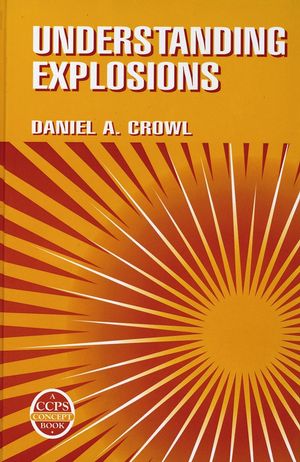Understanding ExplosionsISBN: 978-0-8169-0779-3
Hardcover
228 pages
July 2003
 This is a Print-on-Demand title. It will be printed specifically to fill your order. Please allow an additional 15-20 days delivery time. The book is not returnable.
|
||||||
PREFACE ix
ACKNOWLEDGMENTS xi
1 INTRODUCTION 1
1.1. Accident Loss History 3
1.2. The Accident Process (AIChE, 2000) 4
1.3. A Case History—Flixborough, England 4
1.4. Hazard Identification and Evaluation 6
1.5. Inherently Safer Design 7
2 FUNDAMENTALS OF FIRES AND EXPLOSIONS 9
2.1. Gases and Vapors 13
2.1.1. Flammability Diagram 18
2.1.2. Estimating Flammability Limits 28
2.1.3. Temperature Effect on Flammability 30
2.1.4. Pressure Effect on Flammability 31
2.1.5. Flammability of Gaseous Mixtures 31
2.1.6. Minimum Ignition Energies 32
2.1.7. Autoignition Temperature 34
2.1.8. Example Applications 34
2.2. Liquids 37
2.2.1. Flashpoints of Mixtures of Liquids 40
2.2.2. Example Applications 42
2.3. Aerosols and Mists 43
2.4. Dusts 43
2.5. Hybrid Mixtures 48
2.6. Kinetics and Thermochemistry 48
2.6.1. Calculated Adiabatic Flame Temperatures (CAFT) 50
2.6.2. Example Application 52
2.7. Gas Dynamics 54
2.7.1. Detonations and Deflagrations 58
2.7.2. Estimating Peak Side-on Overpressures 61
2.7.3. Example Applications 62
2.7.4. Pressure Piling and Deflagration to Detonation Transition 63
2.8. Physical Explosions 64
2.8.1. BLEVEs 65
2.8.2. Rapid Phase Transition Explosions 67
2.9. Vapor Cloud Explosions 68
2.9.1. TNT Equivalency 70
2.9.2. TNO Multi-Energy Method 71
2.9.3. Baker-Strehlow-TangMethod(AIChE, 1999a) 77
2.9.4. Computational Fluid Mechanics (CFD) Method 82
2.9.5. Example Applications 83
2.10. Runaway Reactions 85
2.10.1. Steady-State and Dynamic Reactor Behavior 88
2.10.2. Experimental Characterization 92
2.11. Condensed Phase Explosions 94
2.12. Fireballs, Pool, Flash, and Jet Fires 96
2.13. Explosion Effects 98
2.13.1. Thermal Exposure 98
2.13.2. Overpressure Exposure 99
2.14. Ignition Sources 103
2.14.1. Static Electricity 105
3 PREVENTION AND MITIGATION OF EXPLOSIONS 113
3.1. Additional References 113
3.2. Inherently Safer Design 113
3.3. Using the Flammability Diagram to Avoid Flammable Atmospheres 117
3.4. Inerting and Purging 120
3.4.1. Vacuum Purging 121
3.4.2. Pressure Purging 123
3.4.3. Combined Pressure-Vacuum Purging 124
3.4.4. Sweep Purging 126
3.4.5. Siphon Purging 127
3.4.6. Advantages and Disadvantages of the Various Inerting Procedures 127
3.4.7. Inert Gas Blanketing of Storage Vessels 128
3.4.8. Inert Purging and Blanketing during Drumming Operations 128
3.5. Example Application 130
3.6. Explosion Venting 132
3.7. Grounding and Bonding 132
3.8. Ventilation 138
3.9. Sprinkler and Deluge Systems 139
3.10. Charging and Drumming Flammable Liquids 142
3.11. Example Application 142
3.12. Charging Powders 145
3.13. Electrical Equipment in Hazardous (Classified) Areas 148
3.13.1. Protection Techniques 156
Appendix A DETAILED EQUATIONS FOR FLAMMABILITY DIAGRAMS 161
Part A: Equations Useful for Gas Mixtures 161
Part B: Equations Useful for Placing Vessels Into and Out of Service 165
Appendix B EQUATIONS FOR DETERMINING THE ENERGY OF EXPLOSION 169
B.l. Example Application 171
Appendix C FLAMMABILITY DATA FOR SELECTED MATERIALS 173
Appendix D PROCEDURE FOR EXAMPLE 3.2 177
Appendix E COMBUSTION DATA FOR DUST CLOUDS 191
REFERENCES 193
GLOSSARY 203
INDEX 209



